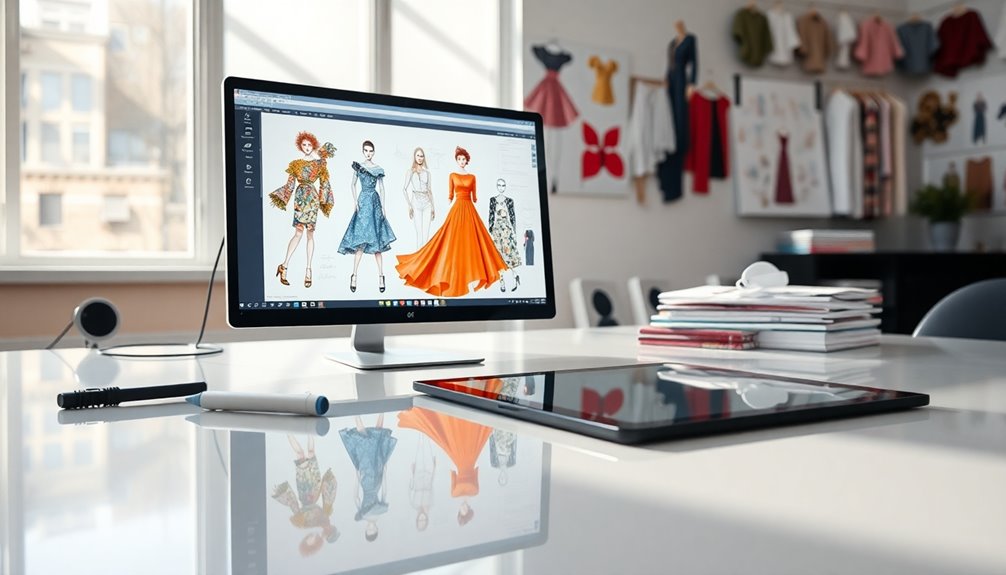To succeed in the fashion industry, you'll need a mix of essential skills. First, nurture your creative vision and design capabilities; mastering sketching and design software is crucial. Next, get comfortable with business acumen, including budgeting and financial management. Strong communication is vital for pitching ideas and building professional relationships. Don't forget about leadership skills, as managing teams effectively can boost productivity. Lastly, embrace analytical skills to understand market trends and consumer preferences. Each ability complements the others, creating a robust skill set that can elevate your career. Curious about more specific skills? There's plenty more to explore!
Key Takeaways
- Strong creative vision and proficiency in design software are essential for developing impactful fashion pieces.
- Solid business acumen, including financial management and budgeting, is crucial for sustainable growth in the fashion industry.
- Effective communication and networking skills help build relationships and open opportunities within the competitive fashion landscape.
- Analytical skills, including trend analysis and supply chain assessment, enable informed decision-making and market insight.
- Leadership abilities, such as conflict management and team motivation, foster collaboration and drive success in fashion projects.
Creative Vision and Design Skills

In the world of fashion, having a strong creative vision is essential for anyone looking to make an impact. You need to cultivate an artistic vision that shapes your brand's direction, allowing you to translate abstract ideas into visually stunning concepts. A keen eye for detail, color, and composition helps you bring your ideas to life, ensuring that you effectively communicate your brand's story through captivating visuals.
Your design skills play a crucial role in this creative process. You should be proficient in sketching, drawing, and using design software to develop innovative designs from concept to production. Understanding color theory and the relationships between colors will enhance your ability to create harmonious patterns that resonate with your audience. Additionally, a strong focus on attention to detail ensures that every element of your designs meets high standards of quality. Furthermore, being aware of sustainable fashion practices can elevate your designs, appealing to the growing market of eco-conscious consumers.
Additionally, trend awareness and forecasting will keep you ahead in the fast-paced fashion industry. By integrating trend knowledge into your creative vision, you can ensure your designs remain relevant and appealing.
Ultimately, your capacity to fuse creativity with strategic collaboration empowers you to lead teams in producing extraordinary work that captivates audiences and solidifies your brand identity.
Fabric and Material Knowledge

Understanding fabric and material knowledge is crucial for anyone in the fashion industry, as it directly impacts your design choices and the overall quality of your creations. You need to familiarize yourself with the different types of fabrics—natural fibers like cotton, wool, and silk; synthetic fibers such as polyester and nylon; and blended fabrics that combine both to optimize their properties.
Knowing the properties of fabrics helps you make informed decisions. For instance, consider the texture, weight, and drape: lightweight chiffon flows beautifully, while heavy denim offers durability. Think about how these properties affect your designs, especially in terms of seasonal suitability—wool is ideal for winter, while linen works well in the summer. Moreover, understanding the history of fabric production provides context for the evolution of materials and their use in contemporary fashion.
Additionally, understanding the production processes, from carding and spinning to weaving and finishing, allows you to appreciate how fabrics are made and treated. This knowledge not only enhances your design but also helps you communicate effectively with manufacturers.
Ultimately, a solid grasp of fabric and material knowledge will empower you to create innovative, high-quality fashion pieces that resonate with consumers.
Business and Financial Acumen

Mastering fabric and material knowledge lays a strong foundation, but to truly excel in the fashion industry, you also need sharp business and financial acumen. You must create and maintain strict budgets to avoid financial pitfalls, tracking income and expenses to understand your financial flows.
Setting clear financial goals will serve as your roadmap, allowing you to categorize expenses into fixed and variable costs effectively. Cash flow management is crucial; ensure you manage cash flow cycles to maintain liquidity during off-peak periods. Utilize financial tools to monitor cash inflow and outflow in real time, and always have contingency plans with cash reserves for unexpected expenses or slow sales.
When it comes to investment strategies, analyze potential opportunities like expanding product lines or opening new stores. Develop strategies for sustainable growth while leveraging capital efficiently to maximize returns. Effective cash flow management is essential for maintaining operational stability in your fashion business, ensuring you can meet financial obligations without strain.
Secure investments from various sources, including bank loans and venture capital, making sure to allocate budgets wisely into product development, marketing, and logistics. Finally, interpret financial data to make informed business decisions and create comprehensive business plans with realistic financial projections to stay competitive in the ever-evolving fashion landscape.
Leadership and Team Management

Effective leadership in fashion not only drives team performance but also shapes the creative vision of the brand. To lead effectively, you need to set clear goals and objectives. Make sure these goals are specific, measurable, achievable, relevant, and time-bound (SMART). This gives your team a sense of purpose and direction while aligning their efforts with the company's objectives.
Understanding your team members' strengths allows you to delegate tasks effectively. Assign responsibilities that maximize their productivity and quality output. While providing guidance, encourage ownership of their work to foster independence. Additionally, fostering a culture of operational efficiency ensures that your team can work effectively towards common goals.
Building a motivated team requires a culture of trust. Be honest and transparent, offering growth opportunities and resources for success. Encourage open dialogue and adapt to new ideas as they arise. Recognize and celebrate achievements to keep morale high.
Conflicts are inevitable, but how you manage them matters. Address issues proactively and promote a problem-solving culture. View failures as learning opportunities and stay updated with industry trends.
Communication and Presentation Skills

Communicating clearly and presenting confidently are essential skills in the fashion industry that can make or break your success. When you're pitching design concepts or showcasing a collection to potential buyers, your ability to deliver a compelling presentation is crucial. You need to articulate the inspiration and aesthetics behind your designs, ensuring clarity and persuasiveness in your message. Fashion communication is about showcasing looks and concepts effectively, which can elevate your presentations to a new level. Incorporating audience engagement strategies can further enhance the impact of your presentations. Additionally, leveraging AI-driven insights can help tailor your presentations to better meet audience preferences.
Tailoring your presentations to your target audience will help them resonate with your ideas.
Networking and relationship building are also vital, and strong communication skills play a key role here. You must effectively express your ideas while listening to others, creating collaborative opportunities with designers, suppliers, and influencers.
Building relationships with press and editors enhances your external communication and can open doors for your career.
In today's digital landscape, social media has become a powerful tool for fashion communication. You'll want to create visually appealing content and engage authentically with your audience.
A consistent brand image across all channels solidifies your presence in the industry. Mastering communication and presentation skills not only enhances your career prospects but also elevates your ability to tell compelling stories through fashion.
Analytical and Problem-Solving Skills

In the fast-paced world of fashion, you need to sharpen your analytical and problem-solving skills to stay ahead of the competition. Analyzing trends is crucial; you must identify and interpret shifts in consumer preferences and market dynamics. By examining consumer data, you can make informed design and business decisions that resonate with your audience.
Financial performance analysis is equally important. You need to evaluate financial data to assess your business's health and pinpoint areas for improvement. Understanding your supply chain is vital too; assess its efficiency to identify bottlenecks and optimize logistics, ensuring timely delivery of your products. Moreover, mastering the art of problem-solving is essential for optimizing supply chain efficiency and reducing lead times.
When it comes to problem-solving, employing techniques like the 5 Whys method can help you uncover root causes. Utilize tools like the Fishbone Diagram to visualize potential issues, and apply the 80-20 Analysis to focus on the most impactful factors.
Remember to define problems clearly, break them down into manageable parts, and develop countermeasures based on thorough analysis. Implement solutions collaboratively and monitor their effectiveness, standardizing successful approaches to prevent future issues.
Technical and Digital Proficiency

Technical and digital proficiency is essential for anyone looking to thrive in the fashion industry today. Mastering pattern making and garment construction allows you to translate your design concepts into real, wearable pieces.
You'll need to create accurate patterns, understand sewing techniques, and make fitting adjustments for the perfect silhouette. Additionally, a solid grasp of textile knowledge helps you select the right fabrics, utilizing manipulation skills like draping and pleating to add unique textures. Attention to detail is crucial throughout this process, ensuring quality from the initial concept to the final product. Mastery of pattern making is fundamental for aspiring fashion designers and pattern makers as it enables them to realize their creative visions with precision.
In the digital realm, proficiency in computer-aided design (CAD) software enables you to create meticulous digital prototypes and streamline design iterations. You'll simulate fabric behavior and manage virtual designs effectively, which is vital in modern manufacturing.
Embracing digital transformation technologies, from automation to AI, will enhance operational efficiency and reduce time to market. Finally, understanding digital marketing and e-commerce strategies allows you to reach your target audience effectively, ensuring your designs don't just exist but thrive in a competitive market.
Balancing these technical and digital skills is key to your success in fashion.
Market Analysis and Trends

How can you navigate the ever-evolving landscape of fashion market trends?
First, understand that consumer behavior is shifting, with many becoming increasingly price-sensitive due to high inflation. To succeed, you'll need to adapt quickly to these changing preferences and the overwhelming choices consumers face. This saturation can impact engagement, so keep an eye on what resonates with your target audience. Additionally, the global tea market has shown that consumers are increasingly interested in products that offer health benefits, which can inform marketing strategies across various industries. Utilizing analytics cookies can provide valuable insights into consumer interactions and preferences. Furthermore, understanding the importance of multilateral organizations can help brands navigate the complexities of international trade and regulations that affect the fashion industry.
Next, be aware of the economic outlook. The fashion industry is experiencing sluggish growth, with most revenue increases predicted to be in the low single digits. Non-luxury sectors are likely to lead profit growth, highlighting a shift that you must consider in your strategies.
Sustainability is another crucial factor. Despite some executives feeling it's losing importance, climate activism remains a pivotal concern for consumers. Embracing sustainable materials and practices will help build long-term trust with your audience. Additionally, the rise in environmentally-conscious consumer demand indicates that brands must genuinely commit to sustainable practices to remain competitive.
Finally, stay updated on technological trends. AI-powered curation and e-commerce are growing rapidly, changing how consumers discover brands. The shift towards online sales in industries like tea shows the importance of adapting to new consumption patterns.
Negotiation and Vendor Management

Navigating market trends effectively sets the stage for successful negotiation and vendor management in the fashion industry. To do this, you'll need to prepare thoroughly. Gather extensive information about your counterpart, including their needs and limitations. Understanding market trends and pricing benchmarks is crucial, along with evaluating supply-demand dynamics and comparing prices for materials. Increased preparation correlates with higher negotiation confidence, which can significantly impact the outcome.
When you enter negotiations, employ effective tactics. Set an initial price as a reference point using anchoring, and frame your offers to highlight benefits and value. Always keep your BATNA (Best Alternative To a Negotiated Agreement) in mind, showcasing strong alternatives while being open to concessions. Use positive language to foster a cooperative atmosphere.
Aim for mutually beneficial agreements by considering innovative solutions. Explore alternative payment arrangements or long-term contracts that meet both parties' needs. Documenting agreements in writing is essential to prevent misunderstandings.
Throughout the process, maintain professionalism. Stay calm and assertive, focusing on logical arguments while summarizing key points for clarity.
Finally, supervise the execution of agreements and address any issues promptly to ensure a smooth partnership. These skills are vital for thriving in fashion negotiation and vendor management.
Building Professional Relationships

Building professional relationships in the fashion industry is essential for career growth and collaboration. To expand your network, attend fashion events like runway shows and industry parties. These gatherings are perfect opportunities to connect with photographers, designers, stylists, and other creatives. Networking is essential for breaking into the competitive fashion industry, as it opens doors to various opportunities and collaborations. Additionally, couples who work together in creative fields often report higher satisfaction in their partnerships, which can translate to a more enriching professional experience. Engaging with puppy training classes can also provide insights into teamwork and collaboration, as they require cooperation and communication among participants. Regular quality time spent with colleagues can further enhance collaboration and trust within your professional relationships.
Utilize social media platforms such as Instagram, TikTok, and LinkedIn to showcase your work and engage with industry professionals.
Creating genuine connections is key. Focus on building authentic relationships rather than just exchanging business cards. Stay in touch with your contacts, follow up after events, and show interest in their projects.
Prioritize quality over quantity, nurturing meaningful connections that can lead to long-term partnerships.
Leverage fashion events to immerse yourself in the community. Introduce yourself to everyone you meet and express genuine curiosity about their roles. Make connections with other fashion enthusiasts and professionals, exchanging tips and advice. As you network, keep an eye out for career girl outfit ideas that resonate with your personal style and professional image. Take notes on new trends and styles that you can incorporate into your own wardrobe, and don’t be afraid to ask for fashion advice from those whose style you admire. These events provide a great opportunity to learn and grow within the fashion community.
Use social media to stay updated on upcoming events and make a lasting impression by demonstrating your personality and professionalism.
Finally, actively engage with industry professionals online. Share their content, participate in discussions, and contribute to online communities.
This proactive approach will enhance your visibility and help you attract potential collaborators or clients.
Frequently Asked Questions
What Educational Qualifications Are Needed to Enter the Fashion Industry?
To enter the fashion industry, you'll typically need at least a bachelor's degree in fashion, which usually takes four years.
An associate's degree can be a quicker, cost-effective option, while a master's degree offers advanced expertise for management roles.
Additionally, pursuing a certificate in fashion design can help you specialize.
Practical experience through internships and developing a strong portfolio are crucial steps to stand out as you start your fashion career.
How Important Is Networking in Building a Fashion Career?
Networking's crucial in building your fashion career. It opens doors to industry connections, job opportunities, and valuable insights.
By attending events and engaging on social media, you'll meet designers, stylists, and other professionals who can guide you. Exchanging business cards and following up solidifies these relationships.
Remember, showcasing your talent at events not only builds credibility but also attracts potential collaborators.
Strong networks can lead to long-term career growth and innovation.
What Are Common Entry-Level Positions in Fashion?
In fashion, you'll find several common entry-level positions to kickstart your career.
You might consider roles like Assistant Designer, where you support senior designers with sketches and trend research.
As a Production Assistant, you'd help with product development.
Alternatively, you could explore retail as an Apparel Associate, selling clothing and assisting customers.
There's also the opportunity to work as a Visual Merchandiser, creating appealing displays to attract shoppers.
How Can I Build a Strong Portfolio for Fashion Jobs?
To build a strong portfolio for fashion jobs, gather your best designs and sketches, focusing on variety.
Organize your work in a way that tells your creative story, using clear layouts and personal branding.
Include technical drawings and mood boards to showcase your process.
Use high-quality images that highlight fit and style.
Aim for quality over quantity, ensuring everything reflects your growth and current trends in fashion.
What Trends Are Currently Shaping the Fashion Job Market?
You'll notice several trends shaping the fashion job market today.
Human-centric retail strategies emphasize the importance of quality customer interactions, while digital and AI skills are increasingly vital for recruitment and marketing.
Non-traditional roles like sustainability managers and data analysts are emerging, addressing new industry challenges.
Additionally, global market dynamics are shifting, with countries like India and Japan becoming growth engines, prompting brands to diversify sourcing strategies and adapt to changing consumer preferences.
Conclusion
To thrive in the fashion industry, you need a blend of creativity, business savvy, and strong communication skills. Embrace your design vision while honing your understanding of fabrics and market trends. Don't underestimate the importance of building relationships and mastering digital tools. Whether you're leading a team or negotiating with vendors, each skill plays a vital role in your success. By developing these abilities, you'll be well-equipped to make your mark in this dynamic field.









